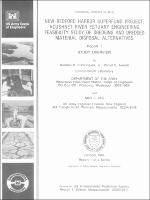Please use this identifier to cite or link to this item:
https://hdl.handle.net/11681/10027Full metadata record
| DC Field | Value | Language |
|---|---|---|
| dc.contributor | United States. Army. Corps of Engineers. New England District | - |
| dc.contributor | US Environmental Protection Agency. Region 1 | - |
| dc.contributor.author | Francingues, Norman R. | - |
| dc.contributor.author | Averett, Daniel E. | - |
| dc.contributor.author | Otis, Mark J. | - |
| dc.date.accessioned | 2016-06-20T13:50:10Z | - |
| dc.date.available | 2016-06-20T13:50:10Z | - |
| dc.date.issued | 1988-10 | - |
| dc.identifier.uri | http://hdl.handle.net/11681/10027 | - |
| dc.description | Technical report | - |
| dc.description | Partial Abstract: Sediments in the New Bedford Harbor and Acushnet River Estuary have been contaminated with polychlorinated biphenyl compounds and heavy metals. The high levels of contamination have resulted in the New Bedford Harbor being placed on the National Priorities List of the Nation's worst hazardous waste sites. Efforts are under way to develop and implement remedial actions for protection of the environment under the Federal Superfund Program. | - |
| dc.publisher | U. S. Army Engineer, Waterways Experiment Station. Environmental Laboratory | - |
| dc.publisher | Engineer Research and Development Center (U.S.) | - |
| dc.relation | http://acwc.sdp.sirsi.net/client/en_US/search/asset/1002883 | - |
| dc.relation.ispartofseries | Technical report (U.S. Army Engineer Waterways Experiment Station) ; EL-88-15 rept. 1. | - |
| dc.rights | Approved for public release; distribution is unlimited. | - |
| dc.source | This Digital Resource was created from scans of the Print Resource. | - |
| dc.subject | Contaminated sediments | - |
| dc.subject | Dredged material disposal | - |
| dc.subject | Dredging | - |
| dc.subject | New Bedford Harbor | - |
| dc.subject | Superfund Feasibility Study | - |
| dc.title | New Bedford Harbor Superfund Project, Acushnet River Estuary engineering feasibility study of dredging and dredged material disposal alternatives. Report 1, Study overview | - |
| dc.type | Report | en_US |
| Appears in Collections: | Technical Report | |
Files in This Item:
| File | Description | Size | Format | |
|---|---|---|---|---|
| TR EL-88-15 Report 1.pdf | 4.6 MB | Adobe PDF |  View/Open |